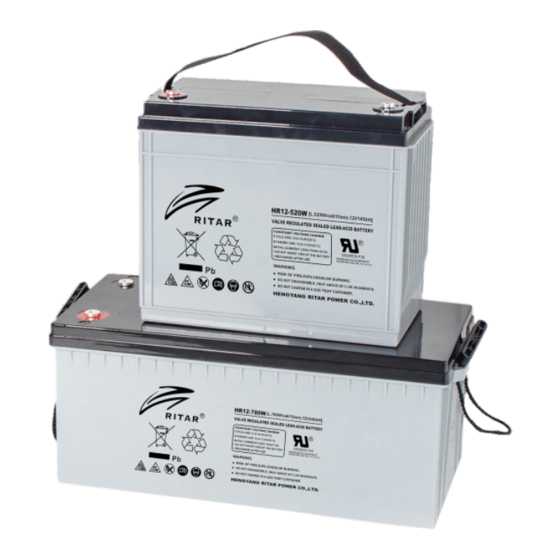Table of Contents
Advertisement
Advertisement
Table of Contents

Summary of Contents for RITAR HR Series
- Page 1 RITAR INTERNATIONNAL GROUP LIMITED Technical Manual Series VRLA Battery...
-
Page 2: Table Of Contents
Contents Page Item Prolegomenon 1 Application Range 2 Check 3 Storage before Installation 4 Installation Cautions 5 Battery Installation 6 Battery Features 7 Working Principle 8 Battery Charge, Discharge & Life 9 Record 10 Maintenance 11 Common Faults & Solutions... -
Page 3: Prolegomenon
Prolegomenon In order to install and use RITAR HR series battery correctly and safely, please read this technical manual and other data together with battery carefully for a comprehensive understanding. Pay attention to safety during installation to avoid accident. I t is required for users to read this manual carefully and keep it well. -
Page 4: Check
Capcity Dimension(mm) 15min/1.67VPC Voltage Weight Model Terminal (Kg) Lenght Width Height Total Height HR12-380SW 306.5 168.5 30.0 F12(M8) HR12-450W 36.5 F12(M8) HR12-520W 44.0 F12(M8) HR12-580W 47.0 F12(M8) HR12-570W 46.0 F12(M8) HR12-570SW 45.0 F12(M8) 56.0 HR12-600W F12(M8) HR12-650W 61.0 F10(M8) HR12-690W 63.5 F10(M8) HR12-780W... -
Page 5: Battery Installation
6. Fix the bolts and nuts on the connection terminals of the battery to the specified torque; otherwise it may cause sparks or damages to the terminals. 7. Please clean the battery shell and cover with a damp cloth; to prevent static and spark, do not use a duster or a dry cloth to clean the battery. -
Page 6: Battery Features
4. Low Self Discharge Because of the use of lead-calcium grids alloy, RITAR batteries have low self discharge and reliable performance. In room temperature, self discharge ratio per month of RITAR battery is about 3% of the battery capacity. -
Page 7: Battery Charge, Discharge & Life
(lead sulfate dioxide alumina) (lead sulfate sponge lead) (dioxide alumina ( sponge lead lead sulfate) lead sulfate) sulfuric acid water, proportion decrease) water sulfuric acid, proportion rise) Battery Charge, Discharge & Life 1. Charge Characteristics Charge condition is one of the most important factors in battery use. The battery performance and service life are directly related to its charging methods and charging parameters in using. - Page 8 2.40 Charge Volume voltage but limited current method At 20 0.30 2.20 Discharge the charge voltage of HR series battery is 2.40V 0.24 Charge with Constant Voltage & Limited Current : 0.18 Charge Voltage: 2.40V/Cell Charge Current: 0.2C A per cell the initial charge current is not larger than Temperature: 25℃/77℉...
- Page 9 Storage Time vs Charge Voltage and Charge Time Storage Time (Month) Charge Voltage (V/Cell) Maximum Charge Current(A) Charge Time(Hr) 0.3C 2.43 0.3C 2.43 6~12 7. Discharge Characteristic According to the difference of discharge rate, Discharge Characteristic Curves the cutoff voltage is also different. Larger 2 .1 0 discharge current sets lower cutoff voltage;...
-
Page 10: Record
8. Float Life Characteristic At recommended float charging situation at 25℃, HR series battery design life is over 15 years. Battery's usage lifetime is related with ambient temperature, depth of discharge, discharge rate and float charging voltage. In real usage, deep discharge, frequent discharge, incorrect float charging voltage will effect the battery lifetime directly. -
Page 11: Maintenance
Maintenance Put on a mask or a pair of protective glasses when approach batteries, make sure not put batteries next to fire/ smoking place. Proper maintenance can prolong battery life and help it meet the design requirements. A good battery maintenance program can help to judge when battery need to be replaced. -
Page 12: Common Faults & Solutions
3. Battery cleaning Use cloth soaked in water or carbonic acid water to clear battery and cover. 4. Capacity test If batteries work properly, no need to check capacity. Check capacity only when battery capacity is in doubt. When battery is in discharge, the cut-off voltage should not be lower than the requirement in the technical manual.




Need help?
Do you have a question about the HR Series and is the answer not in the manual?
Questions and answers